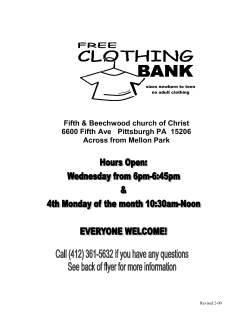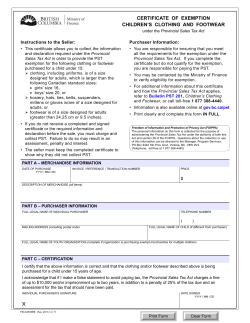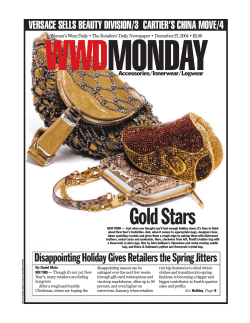
Children’s Apparel Industry Overview U.S. Children's Apparel Sales
Children’s Apparel U.S. Children's Apparel Sales by Distribution Channels Industry Overview Mass merchandisers 29.7% Specialty retailers 24.3% Children’s apparel represents nearly 20% of the U.S. retail apparel industry. Within the segment, sales of infants’ and toddlers’ apparel accounts for a greater percentage of all children’s apparel than do sales of boys’ or girls’ clothing. Other - 2.7% Mail/e-tail - 2.3% Off-price retailers/ outlets - 8.2% National chains 22.8% U.S. Apparel Sales, by Market Segment % of $165 Billion in Retail Sales Department stores 10.0% Source: Children's Business, "Industry Market Report Card," May 2004. Women's apparel - 53.6% Children's apparel - 17.8% Men's apparel - 28.6% Children's Apparel: $29.4 Billion Infants/ toddlers 36% Girls' - 34% Boys' - 30% Source: Children's Business, "Industry Market Report Card," May 2004. Department stores and independent specialty stores were once the principal places parents shopped for clothing for their children. In recent years, department stores have lost substantial market share to mass merchandisers like Wal-Mart and Target. Specialty stores continue to maintain an important presence in the industry -- though they, too, have lost sales to mass merchandisers as well as to national chains. They still hold nearly a quarter of the market share for children’s clothing, behind mass merchandisers but still ahead of national chains, as illustrated in the following chart: Within the last decade, numerous national chains that sell adult apparel launched spin-off chains that specialize in children’s clothing. They are often located in malls right next to their adult counterparts, and the name recognition has fueled tremendous growth for these stores. Some of the biggest names include: GapKids/BabyGap - 1166 stores Limited Too - 553 stores Babies R Us - 199 stores abercrombie* - 167 stores Talbots Kids - 68 stores Guess Kids - 83 stores Benetton Kids - 28 stores Other important national chains include The Children’s Place, with 691 stores in the U.S., and Gymboree, which operates 619 stores. Off-price retailers, also known as discount retailers, include national chains such as T.J. Maxx, Marshall’s, Ross Dress For Less Stores and Loehmann’s. These retailers, like department stores, carry men’s and women’s clothing as well as children’s wear. Factory outlet malls are also an increasingly popular option for price-conscious parents looking for fashionable clothes for their kids. Osh Kosh B’Gosh, a well known manufacturer of children’s clothing, operates 165 companyowned stores in factory outlets across the country. * The “a” is intended to be lowercase. 4.1 Issues and Trends Children’s clothing has been the darling of the retail apparel industry for several years, according to an article in Apparel Magazine (November 2004). Unlike other depressed segments of the industry, children’s clothing sales have increased every year since 1998, with the exception of the 2001 holiday season that followed the September 11th terrorist attacks. Led by girls’ apparel, the overall sales of children’s clothing between August 2003 and July 2004 grew to $29.1 billion, a 1.7% increase of $28.6 billion from the previous 12 months. Some of the biggest business trends in the children’s apparel industry follow: A heavy injection of fashion has stimulated sales and brought a renewed sense of excitement to kids’ clothing. Fashion trends driving children’s apparel include the following: Children’s Apparel Fashion Trends Children’s fashion mimics adult wear. With parents and children across multiple economic lines becoming more fashion savvy, children’s apparel trends are increasingly influenced by adult fashions. The market has become characterized as a peculiar cross-section of more contemporary yet conservative styles with edgier, urban looks. Celebrities in the mix. Madonna recently announced she will launch a children’s clothing line at Nordstrom, with fashions inspired by her children’s book, The English Roses. Celine Dion is also designing a line of children’s wear. Baby boomers splurge on the grandchildren. Stylish boomers, the oldest of which are approaching 60, have paid for their children’s college tuitions and weddings and are now looking to lavish attention on their children’s children. A growing number of specialty stores are marketing to these grandparents -- many of whom can afford to spend $350 on cashmere baby blankets and $100 or more for Dolce & Gabana footwear for girls. Unusual accessories are in. With more schools enforcing dress codes, makers of student gear are taking advantage of the situation by tempting kids with self-expressive accessories, including zebra-striped combination locks and calculators with interchangeable and colorful face-plates. Children’s Apparel Industry Trends Specialty retailers and second-tier department stores gain ground. Sales for specialty retailers for children grew an impressive 17% in 2003. Even more surprising, though, is that sales in second-tier department stores like Sears, J.C. Penney and Kohl’s grew 19% in 2003. These stores, which focus more on reasonably-priced clothes than do higher-end department stores like Saks and Macy’s, have noted the recent success of children’s clothing -- and have focused on improving the shopping experience within their kids’ apparel departments. Sears joins with Gerber. Sears has honed in specifically on the infant-toddler market. The chain joined forces with Gerber to add a line of baby clothes and accessories called Gerber Beginnings. The line will include gowns, bibs, blankets, cap and bootie sets, coordinated pants and jackets, and “sleep’n’play” outfits. The stores are also removing clutter by cutting 15% of the clothing racks from the children’s department so parents can better maneuver strollers down the aisles. The Children’s Place races ahead. The Children’s Place is currently the fastest-growing chain in the industry. The chain’s net income increased 158% in 2003. Customers have responded to the company’s philosophy of providing everyday value with highquality merchandise. In late 2004, the company announced it would buy the Disney Stores chain, which operates 335 stores nationally. Consumers still demand lower prices. Despite overall growth in children’s clothing, pricing remains a big issue. With the economy still recovering, consumers remain on the lookout for bargains. Parents will often hold out for sales before buying clothes for their kids. Higher-end department stores have begun clearing out excess brand names in favor of more attractively priced private labels. Sources for Industry Trends and Fashion Trends: Women’s Wear Daily, November 11, 2004; Apparel, November 2004; The Columbus Dispatch, August 27, 2004; The Wall Street Journal, August 24, 2004. Despite the popularity of specialty stores, mass merchandisers dominate the list of the nation’s highestvolume retailers of children’s clothing: Retailer Name # of S tores 2003 sales* Wal-Mart 2,949 $7.8 bi lli on Target 1,225 $2.2 bi lli on Sears 871 $1.7 bi lli on 1,049 $1.5 bi lli on Old Navy 840 $1.4 bi lli on Kohl's 542 $1.3 bi lli on K-Mart 1,511 $1.2 bi lli on GapKi ds/BabyGap 1,166 $1.1 bi lli on Federated** 458 $1.0 bi lli on Marmaxx*** 1,418 $1.0 bi lli on J.C . Penney *Total company sales; does not solely reflect revenue from children’s apparel. **Company includes Macy’s and Bloomingdales department stores. ***Company includes Marshall’s and T.J. Maxx stores 4.1 Value of Products and Services in the Industry The amount spent annually on children’s clothing can vary dramatically from household to household -- from under $25 to several thousand dollars. According to NPD FashionWorld, the average price of one piece of clothing dropped from $6.02 in 2002 to $5.92 in 2003. Families typically spend more on girls’ clothing than boys’ clothing, according to Household Spending: Who Spends How Much on What (December 2003). Below is a chart illustrating the average household spending on specific girls’ apparel items. Critical Success Factors CSFs for Children’s Apparel Stores Create an uncluttered shopping experience. Avoid stuffing racks too full with clothes. Organize the store so it feels spacious and easy to browse. Define your target market: Does the store appeal to bargain-shoppers looking for quality? Is it a specialty store for well-heeled parents and grandparents? Always keep the targeted shopper in mind when buying clothes with which to stock the store. Focus on unique brands to differentiate the store. This becomes ever more important as retailers in every segment, including mass merchandisers, carry designer labels. Hire warm, patient sales people who like children and know how to gently handle harried parents. Capitalize on the opportunity to become a destination for gift-givers, particularly for newborns. Girls' Apparel Sales by Type of Clothing Skirts and pants $23.61 - 19.1% Dresses and suits - $13.83 11.1% Active sportswear $12.09 - 9.7% Shorts $8.83 7.1% Skirts, blouses and sweaters - $29.37 23.8% Other $28.40 22.9% Accessories $7.66 6.3% Source: Household Spending: Who Spends How Much On What, New Strategist Publishing, December 2003. According to Household Spending, the average family spends $107.28 on children’s clothing -- $123.79 for each girl, $90.77 for each boy. Spending varies dramatically depending on household income and age of the primary householders. Households with an income under $10,000 spend an average of $24.67 on boys’ clothes and $49.75 on girls’ clothes, while households that earn $70,000 or more spend an average of $167.04 on boys’ clothes and $216.57 on girls’ clothes. Not surprisingly, consumers ages 35 to 44 spend the most money on children’s clothing, which averages $206.88 -- $177.20 per boy, $236.57 per girl. Consumers ages 25 to 34 spend $108.96 for each boy and $146.09 for each girl in the family. Sources: The Record, February 27, 2004; Children’s Business, May 2004. Industry Resources American Apparel & Footwear Association 1601 N. Kent Street, Suite 1200 Arlington, VA 22209 703-524-1864 www.apparelandfootwear.org National Retail Federation 325 7th Street NW, Suite 100 Washington, DC 20004 202-783-7971 www.nrf.com Children’s Business Fairchild Publications 7 West 34th St. New York, NY 10001 212-221-9595 www.childrensbusiness.com NPD Group 900 West Shore Road Port Washington, NY 11050 516-625-0700 www.npd.com 4.1 Background Media Marketing, Inc., creators of imMEDIAte® software, has been in the forefront of sales presentation systems since 1987. The imMEDIAte suite, a state-of-the-art consultative system, is used by hundreds of media reps every day to create compelling presentations and expert media proposals. Built on Microsoft Office® technology, the imMEDIAte system provides a complete solution to your media sales needs. Media Marketing is the exclusive distributor of Profile America’s IndustryIQ reports. Sales and marketing teams embrace these industryknowledge reports because of their concise, easy-to-read style and rich store of information. Regular use of IndustryIQ reports creates a relationship-building, consultative environment. Values and Benefits Sales reps want to be smart about advertisers’ industries, but face the realities of limited time and resources. They need to track dozens of different industries, and value these concise, easy-to-use sales tools that they can leave behind with their advertisers. Likewise, managers want reps to be confident, professional and informed. They want their reps viewed as partners, not vendors -- and they appreciate the IndustryIQ method of collecting, analyzing and presenting information. Independent, third-party IndustryIQ reports leave marketing and sales professionals free to practice their core competencies: developing successful advertising strategies for their clients. Since 1986, Profile America has provided profiles of industries, markets and trends to business-to-business marketers, facilitating an understanding of the industries into which they sell their products and services. Delivery Program Objectives IndustryIQ reports are used by managers as sales training, planning and business development tools. Sales reps use IndustryIQ reports to prepare for sales calls and as a valuable leave-behind. Armed with independent, third-party assessment of industry dynamics, media reps can “walk the walk and talk the talk” of their advertisers’ industries, allowing reps to better assist advertisers in creating compelling, effective messages for their target audiences. IndustryIQ reports incorporate a customerguided approach to gathering information and creating industry-knowledge products. We value your content recommendations as we strive to create the most useful, fact-filled industry reports available. IndustryIQ reports are available in PDF format from Media Marketing’s web site, www.IndustryIQ.biz, and as ready-to-show PowerPoint slides that seamlessly integrate with your imMEDIAte presentations. IndustryIQ is distributed by Media Marketing, Inc. in association with Profile America, Inc. for use by advertising sales representatives. Although the information in this report has been obtained from sources that Profile America, Inc. believes to be reliable, no guarantees are made as to the accuracy of the information presented, and any information presented may be incomplete or condensed. 4.1
© Copyright 2025




















![This article was downloaded by: [Arts et Métiers ParisTech], [FREDERIC... On: 14 March 2014, At: 07:15](http://cdn1.abcdocz.com/store/data/000197903_1-06c07e832bfd9d44175a32f8ec443131-250x500.png)
